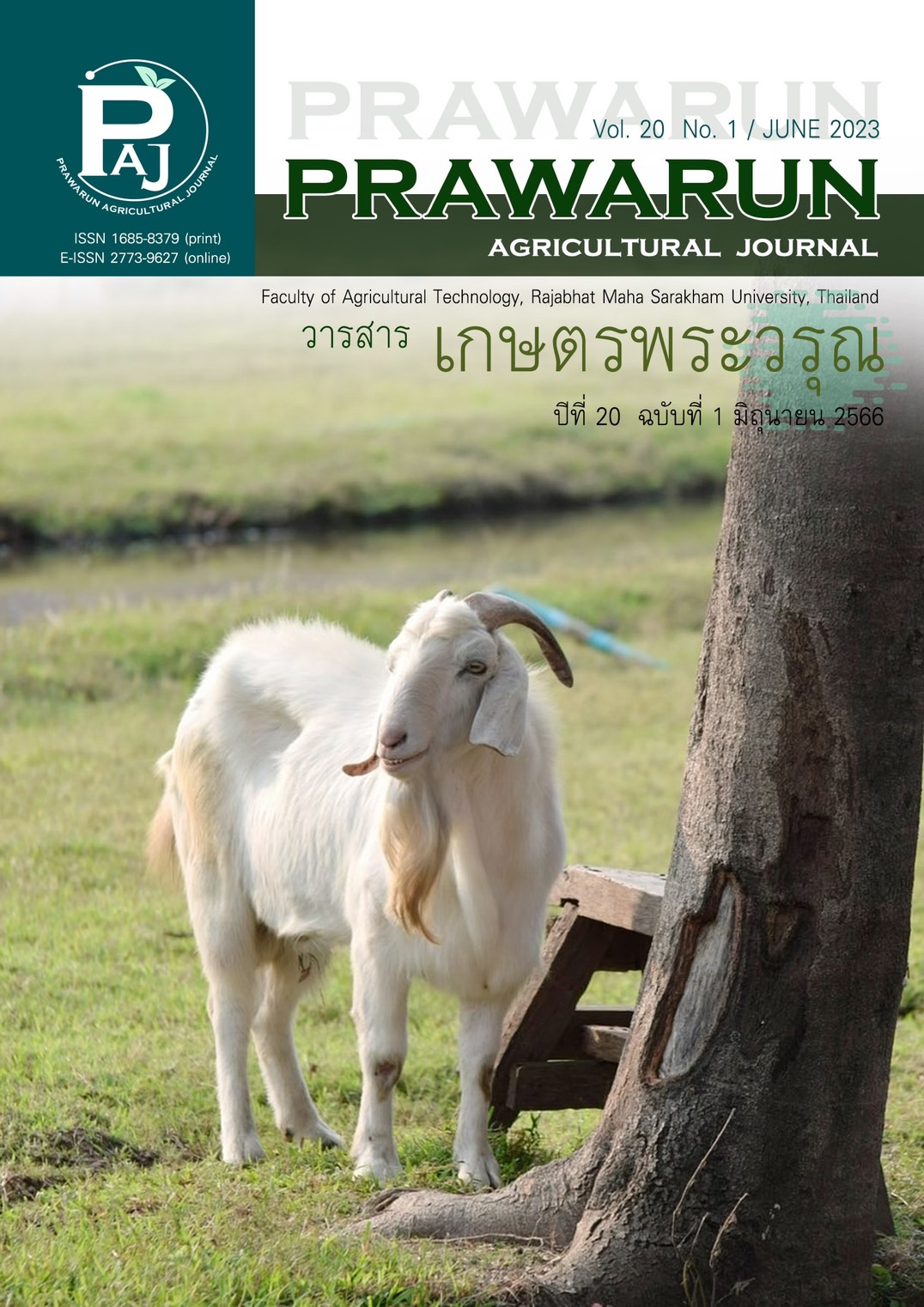การสะสมโลหะหนักในพื้นที่ปลูกข้าวจังหวัดบุรีรัมย์ ประเทศไทย
Main Article Content
บทคัดย่อ
การปนเปื้อนของโลหะหนักในนาข้าวถือเป็นปัญหาที่น่ากังวลในหลายประเทศในเอเชีย การศึกษานี้มีวัตถุประสงค์เพื่อตรวจวัดปริมาณโลหะหนัก (ทองแดง แมงกานีส สังกะสี ตะกั่ว และแคดเมียม) และประเมินการได้รับโลหะหนักต่อวัน ในพื้นที่ปลูกข้าวของจังหวัดบุรีรัมย์ โดยวิเคราะห์ตัวอย่างดิน 62 ตัวอย่าง ตัวอย่างน้ำ 57 ตัวอย่าง ตัวอย่างต้นข้าว 62 ตัวอย่าง และตัวอย่างเมล็ดข้าว 11 ตัวอย่าง ด้วยเครื่อง Atomic absorption spectrophotometer (AAS) และคำนวณหาการได้รับโลหะหนักต่อวัน (Estimated daily intake, EDI) จากการบริโภคข้าวของประชาชนในจังหวัดบุรีรัมย์ ผลการศึกษา พบว่า ปริมาณทองแดงในต้นข้าวมีความแตกต่างกันอย่างมีนัยสำคัญระหว่างพื้นที่ในเขตชลประทานและนอกเขตชลประทาน โดยมีค่าเท่ากับ 4.258 และ 1.963 มิลลิกรัม/กิโลกรัม ตามลำดับ ความเข้มข้นของแมงกานีสพบในดินสูงที่สุด และพบในเมล็ดข้าวน้อยที่สุด ปริมาณตะกั่วพบการสะสมในดินมีความแตกต่างกันอย่างมีนัยสำคัญระหว่างพื้นที่ในเขตชลประทานและนอกเขตชลประทาน โดยมีค่าเท่ากับ 30.85 และ 42.794 มิลลิกรัม/กิโลกรัม ตามลำดับ อย่างไรก็ตาม ในต้นข้าวพบการสะสมของปริมาณตะกั่วสูงที่สุดเท่ากับ 47.858 และ 45.786 มิลลิกรัม/กิโลกรัม ในเขตชลประทานและนอกเขตชลประทาน ตามลำดับ ปริมาณสังกะสีพบสูงที่สุดในต้นข้าว ซึ่งมีค่าเท่ากับ 21.958 และ 23.203 มิลลิกรัม/กิโลกรัม ในเขตชลประทานและนอกเขตชลประทาน ตามลำดับ ปริมาณแคดเมียมพบในน้ำมีความแตกต่างกันอย่างมีนัยสำคัญระหว่างพื้นที่ในเขตชลประทานและนอกเขตชลประทาน โดยมีค่าเท่ากับ 0.0001 และ 0.0011 มิลลิกรัม/ลิตร ตามลำดับ อย่างไรก็ตาม ในเมล็ดข้าว พบการสะสมของแคดเมียมสูงที่สุดเมื่อเทียบกับในดิน น้ำ และต้นข้าว โดยมีค่าเท่ากับ 0.119 และ 0.114 มิลลิกรัม/กิโลกรัม ในเขตชลประทานและนอกเขตชลประทาน ตามลำดับ นอกจากนี้ จากการประเมินค่า EDI พบว่า ไม่เกินค่าที่แนะนำต่อวัน (Recommended daily dietary allowances, RDI) ยกเว้น ปริมาณตะกั่วที่มีค่า EDI (0.39 มิลลิกรัม/คน/วัน) สูงกว่าค่า RDI (0.21 มิลลิกรัม/คน/วัน) การปนเปื้อนโลหะหนักในพื้นที่ปลูกข้าวเกิดจากหลายแหล่งกำเนิด ด้วยเหตุนี้ การทดสอบหาปริมาณโลหะหนักในพื้นที่ปลูกข้าว และติดตามความเสี่ยงต่อสุขภาพของมนุษย์อย่างสม่ำเสมอจึงเป็นสิ่งสำคัญ
Article Details
เอกสารอ้างอิง
Atique Ullah, A. K. M., Maksud, M. A., Khan, S. R., Lutfa, L. N., & Quraishi, S. B. (2017). Dietary intake of heavy metals from eight highly consumed species of cultured fish and possible human health risk implications in Bangladesh. Toxicology Reports, 4, 574-579. doi:10.1016/j.toxrep.2017.10.002
Cheun-im, N., Sinbuathong, N., Ingkapradit, W., Koonket, K., Inklang, V., & Hom-ngarm, V. (2008). Accumulation of heavy metals in soil from organic paddy field. Proceedings of the 46th Kasetsart University annual conference: Plants (pp. 521-525). Bangkok: Kasetsart University. (in Thai)
Dogan, Y., Ugulu, I., Durkan, N., Unver, M. C., & Mert, H. H. (2011). Determination of some ecological characteristics and economical importance of Vitex agnus-castus. Eurasian Journal of Biosciences, 5(5), 10-18. doi:10.5053/ejobios.2011.5.0.2
Erikson, K. M., & Aschner, M. (2003). Manganese neurotoxicity and glutamate-GABA interaction. Neurochemistry International, 43(4-5), 475-480. doi:10.1016/S0197-0186(03)00037-8
Faculty of Environment and Resources Studies, Mahidol University. (n.d.). Environmental quality measurement and analysis service. Accessed June 21, 2023. Retrieved from https://en.mahidol.ac.th/images/lab/publication_edit65.pdf (in Thai)
Feng-Hu, X., Jiang, Y., Shu, Y., Hu, X., Liu, L., & Luo, F. (2014). Effects of mining wastewater discharges on heavy metal pollution and soil enzyme activity of the paddy fields. Journal of Geochemical Exploration, 147(Part B), 139-150. doi:10.1016/j.gexplo.2014.08.001
Inboonchuay, T., Suddhiprakarn, A., Kheoruenromne, I., Anusontpornperm, S., & Gilkes, R. J. (2015). Distribution and concentration of major and trace elements in paddy soils and rice plant of Khorat Basin, Northeast Thailand. Thai Journal of Agricultural Science, 48(3), 147-156.
Javed, M. T., Saleem, M. H., Aslam, S., Rehman, M., Iqbal, N., Begum, R., Ali, S., Alsahli, A. A., Alyemeni, M. N., & Wijaya, L. (2020). Elucidating silicon-mediated distinct morpho-physio-biochemical attributes and organic acid exudation patterns of cadmium stressed Ajwain (Trachyspermum ammi L.). Plant Physiology and Biochemistry, 157, 23–37. doi:10.1016/j.plaphy.2020.10.010
Kingsawat, R., & Roachanakanan, R. (2011). Accumulation and distribution of some heavy metals in water, soil and rice fields along the Pradu and Phi Lok canals, Samut Songkhram Province, Thailand. Environment and Natural Resources Journal, 9(1), 38-48.
Kukusamude, C., & Kongsri, S. (2019). Cadmium concentration in Thai sticky rice and human health risk assessment. Proceedings of the 7th Burapha University international conference on interdisciplinary research (pp. 538-542). Chonburi: Burapha University.
Plum, L. M., Rink, L., & Haase, H. (2010). The essential toxin: impact of zinc on human health. International Journal of Environmental Research and Public Health. 7(4), 1342-1365. doi:10.3390/ijerph7041342
Rehman, M., Liu, L., Wang, Q., Saleem, M. H., Bashir, S., Ullah, S., & Peng, D. (2019). Copper environmental toxicology, recent advances, and future outlook: a review. Environmental Science and Pollution Research, 26(18), 18003-18016. doi:10.1007/s11356-019-05073-6
Reilly, C. (2002). Metal contamination of food (3rd ed.). Oxford: Blackwell Science Ltd.
Rittirong, A., & Saenboonruang, K. (2018). Quantification of aluminum and heavy metal contents in cooked rice samples from Thailand markets using inductively coupled plasma mass spectrometry (ICP-MS) and potential health risk assessment. Emirates Journal of Food and Agriculture, 30(5), 372-380. doi:10.9755/ejfa.2018.v30.i5.1680
Ruiz, L. M., Libedinsky, A., & Elorza, A. A. (2021). Role of copper on mitochondrial function and metabolism. Frontiers in Molecular Biosciences, 8, 711227. doi:10.3389/fmolb.2021.711227
Saleem, M. H., Kamran, M., Zhou, Y., Parveen, A., Rehman, M., Ahmar, S., Malik, Z., Mustafa, A., Anjum, R. M. A., & Wang, B. (2020). Appraising growth, oxidative stress and copper phytoextraction potential of flax (Linum usitatissimum L.) grown in soil differentially spiked with copper. Journal of Environmental Management, 257, 109994. doi:10.1016/j.jenvman.2019.109994
Satachon, P., Keawmoon, S., Rengsungnoen, P., Thummajitsakul, S., & Silprasit, K. (2019). Source and health risk assessment of heavy metals in non-certified organic rice farming at Nakhon Nayok Province, Thailand. Applied Environmental Research, 41(3), 96-106.
Sekara, A., Poniedzialek, M., Ciura, J., & Jedrszczyk, E. (2005). Cadmium and lead accumulation and distribution in the organs of nine crops: implications for phytoremediation. Polish Journal of Environmental Studies, 14(4), 509-516.
Srinuttrakul, W., Permnamtip, V., & Yoshida, S. (2018). Heavy Metals in Sangyod rice samples cultivated in Phatthalung, Thailand. Food and Applied Bioscience Journal, 6(special issue on Food and Applied Bioscience), 45-54.
Sungur, A., Soylak, M., Yilmaz, S., & Ozcan, H. (2016). Heavy metal mobility and potential availability in animal manure: using a sequential extraction procedure. Journal of Material Cycles and Waste Management, 18(3), 563-572. doi:10.1007/s10163-015-0352-4
Uchida, S., Tagami, K., & Ishikawa, N. (2009). Concentration, soil-to-plant transfer factor and soil-soil solution distribution coefficient of selenium in the surface environment. Proceedings of the Waste management symposium (pp. 1-5). Arizona: Phoenix.
United States Environmental Protection Agency (USEPA). (2007). Method 3051A – microwave assisted acid digestion of sediments, sludges, soils, and oils. Accessed April 21, 2023. Retrieved from https://www.epa.gov/sites/default/files/2015-12/documents/3051a.pdf
Waalkes, M. P. (2000). Cadmium carcinogenesis in review. Journal of Inorganic Biochemistry. 79(1-4), 241-244. doi:10.1016/s0162-0134(00)00009-x
Zaheer, I. E., Ali, S., Saleem, M. H., Ali, M., Riaz, M., Javed, S., Sehar, A., Abbas, Z., Rizwan, M., El-Sheikh, M. A., & Alyemeni, M. N. (2020). Interactive role of zinc and iron lysine on Spinacia oleracea L. growth, photosynthesis and antioxidant capacity irrigated with tannery wastewater. Physiology and Molecular Biology of Plants, 26, 2435-2452. doi:10.1007/s12298-020-00912-0


